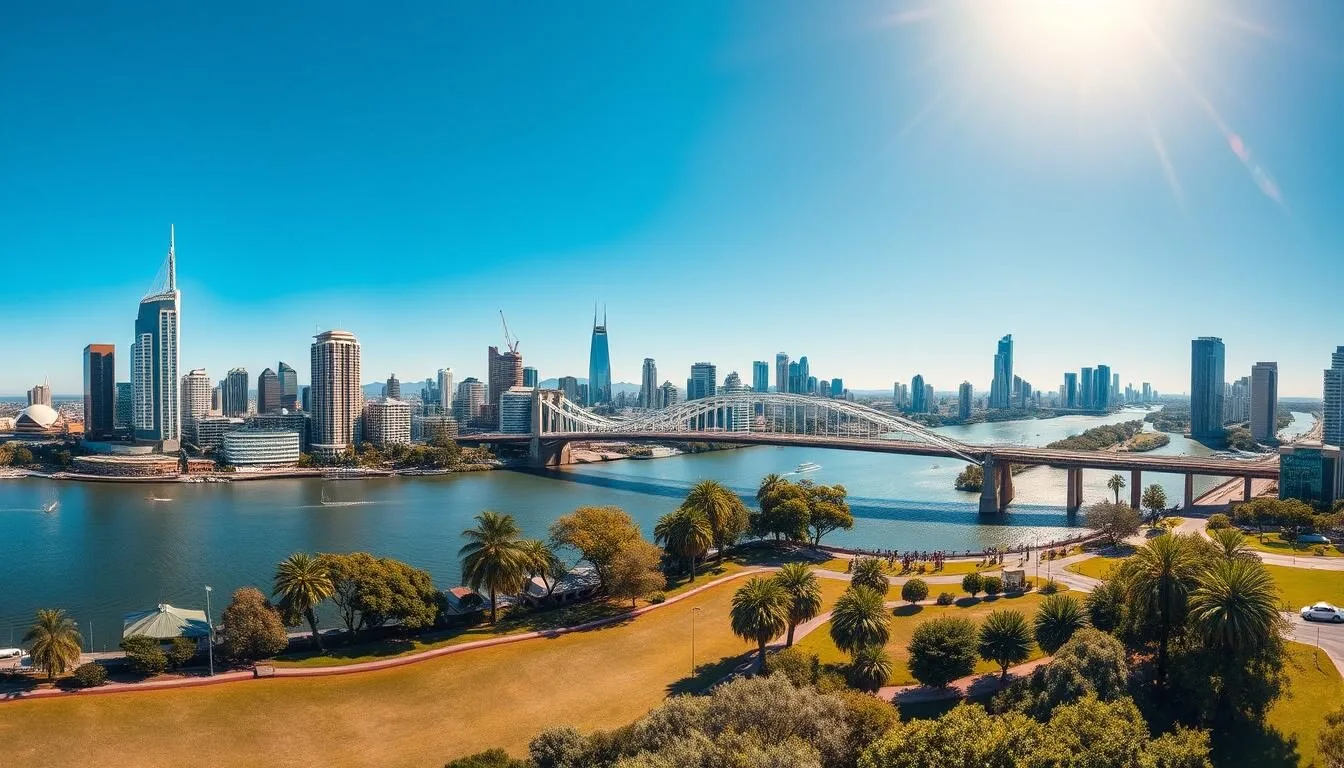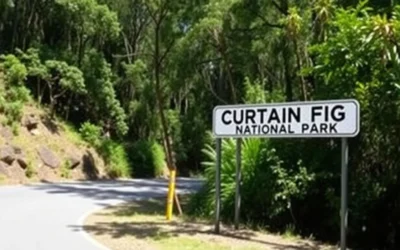Did you know Brisbane enjoys an impressive 283 sunny days per year, making it one of Australia’s most consistently pleasant destinations? This subtropical capital of Queensland boasts a climate that allows for outdoor adventures almost year-round, but timing your visit can make all the difference between a perfectly pleasant holiday and a sticky, storm-filled stay. Let’s explore when to plan your Brisbane adventure for the most weather-perfect experience.
Getting There & Planning Your Journey
Brisbane is served by Brisbane Airport (BNE), a major international gateway to Australia. Direct flights connect Brisbane to major cities across Asia, North America, and the Middle East, while domestic flights link it to all Australian capitals.
Ready to Book Your Brisbane Adventure?
Find the best flight deals to Brisbane and start planning your weather-perfect Queensland getaway.
When planning your trip, consider that the Australian seasons are opposite to those in the Northern Hemisphere. December-February is summer, March-May is autumn, June-August is winter, and September-November is spring. This reversal is crucial when timing your visit for ideal weather conditions.
Best Time to Visit & Weather Tips
Brisbane’s subtropical climate creates distinct seasonal patterns that travelers should consider when planning their visit. While the city rarely experiences extreme cold, the combination of heat and humidity during summer months can be challenging for some visitors.

Month-by-Month Brisbane Weather Guide
| Month | Weather | What to Wear | Things to Do | Pros & Cons |
| January | 22-30°C (72-86°F) 112.8mm (4.4in) rain 73% humidity | Lightweight, breathable clothing Swimwear Rain jacket | Brisbane International tennis Beach days Indoor museums | ✅ Warm water temperatures ❌ High humidity ❌ Afternoon thunderstorms |
| February | 21-29°C (70-84°F) 147.1mm (5.8in) rain 75% humidity | Lightweight clothing Umbrella Waterproof shoes | BrisAsia Festival Queensland Cabaret Festival Gallery visits | ✅ Fewer tourists ❌ Wettest month ❌ Peak humidity |
| March | 20-29°C (68-84°F) 113.6mm (4.5in) rain 75% humidity | Light layers Rain gear Sun protection | Weird Science Festival River cruises Botanic Gardens | ✅ Decreasing humidity ✅ Warm water (26°C/79°F) ❌ Still quite rainy |
| April | 18-27°C (64-81°F) 117.2mm (4.6in) rain 74% humidity | Light layers Light jacket for evenings Rain gear | Oceania Cycling Championships Hiking Moreton Island day trips | ✅ Pleasant temperatures ✅ End of cyclone season ❌ Easter crowds |
| May | 15-24°C (59-75°F) 100.4mm (4in) rain 71% humidity | Layers Light jacket Comfortable walking shoes | Paniyiri Greek Festival Brisbane Comedy Festival Street Art Festival | ✅ Ideal temperatures ✅ Festival season begins ✅ Less rain |
| June | 12-21°C (54-70°F) 54.3mm (2.1in) rain 72% humidity | Layers Light jacket Long pants | State of Origin rugby Whale watching Brisbane Marathon | ✅ Dry weather ✅ Comfortable temperatures ❌ School holiday crowds |
| July | 11-21°C (52-70°F) 56.5mm (2.2in) rain 67% humidity | Layers Jacket for evenings Scarf | Anywhere Festival Hinterland hiking Mt. Coot-tha Lookout | ✅ Lowest humidity ✅ Clear, sunny days ❌ Cooler water temperatures |
| August | 12-22°C (54-72°F) 33.5mm (1.3in) rain 64% humidity | Layers Light jacket Sun protection | The Ekka (Royal Queensland Show) Bridge to Brisbane run Scenic Rim exploring | ✅ Driest month ✅ Low humidity ✅ Jacarandas begin blooming |
| September | 14-24°C (57-75°F) 30.2mm (1.2in) rain 65% humidity | Layers Sun protection Light clothing | Brisbane Festival Riverfire fireworks Brisbane Pride Festival | ✅ Perfect weather ✅ Minimal rain ❌ School holiday crowds |
| October | 16-26°C (61-79°F) 77.3mm (3in) rain 66% humidity | Light clothing Sun protection Light rain gear | Valley Fiesta Brisbane International Film Festival Jacaranda viewing | ✅ Jacarandas in full bloom ✅ Warm but not hot ✅ Increasing daylight |
| November | 19-28°C (66-82°F) 119.1mm (4.7in) rain 69% humidity | Light clothing Sun protection Rain gear | Wynnum Fringe Brisbane Shakespeare Festival Beach days | ✅ Warm water temperatures ❌ Increasing humidity ❌ Start of cyclone season |
| December | 21-30°C (70-86°F) 127.4mm (5in) rain 71% humidity | Lightweight clothing Swimwear Rain gear | Moonlight Cinema Christmas events South Bank swimming | ✅ Festive atmosphere ❌ High humidity ❌ Afternoon storms |
Table Key: ✅ Green rows = Best time to visit | ⚠️ Yellow rows = Acceptable conditions | ❌ Red rows = Less ideal weather
Brisbane’s Seasons at a Glance
Summer (Dec-Feb)
Weather: Hot and humid with afternoon thunderstorms. 21-30°C (70-86°F), high humidity (71-75%).
What to Wear: Lightweight clothing, swimwear, rain gear, sun protection.
Things to Do: Beach days, water activities, air-conditioned museums, early morning walks.
Pros: Warm water temperatures, lively atmosphere.
Cons: High humidity, frequent rain, thunderstorms.
Autumn (Mar-May)
Weather: Gradually cooling with decreasing humidity. 15-29°C (59-84°F), moderate humidity.
What to Wear: Light layers, sun protection, light jacket for evenings.
Things to Do: Outdoor festivals, hiking, river cruises, botanical gardens.
Pros: Pleasant temperatures, fewer crowds (except Easter).
Cons: March still sees significant rainfall.
Winter (Jun-Aug)
Weather: Mild, dry, and sunny. 11-22°C (52-72°F), low humidity (64-72%).
What to Wear: Layers, light jacket, scarf for evenings.
Things to Do: Whale watching, hiking, outdoor markets, sporting events.
Pros: Clear skies, minimal rain, comfortable temperatures.
Cons: Cooler water temperatures, busy with domestic tourists.
Spring (Sep-Nov)
Weather: Warming with increasing humidity. 14-28°C (57-82°F), moderate humidity.
What to Wear: Light clothing, sun protection, light rain gear.
Things to Do: Brisbane Festival, jacaranda viewing, outdoor dining, beach days.
Pros: Beautiful flowering jacarandas, pleasant temperatures.
Cons: Increasing rain and humidity by November.
Best Time to Visit Brisbane
Best Months to Visit
- May to October: Dry season with comfortable temperatures and low humidity
- May: Festival season begins with ideal temperatures
- August-September: Driest months with pleasant temperatures and flowering jacarandas
- April: Pleasant temperatures as humidity decreases
Months to Avoid
- January-February: Peak humidity and rainfall
- December: Beginning of wet season with increasing humidity
- School holiday periods (if seeking fewer crowds): mid-December to late January, early-mid April, late June to mid-July, late September to early October
Getting Around Locally

Brisbane offers excellent public transportation options that are particularly enjoyable during the pleasant weather months. The integrated TransLink network includes buses, trains, and ferries that connect all major attractions.
- CityCat Ferries: A scenic way to travel along the Brisbane River, connecting major precincts. Most enjoyable during winter and spring when the weather is clear.
- Buses and Trains: Extensive network covering the entire city. Air-conditioned comfort is especially appreciated during summer months.
- City Hopper: Free ferry service in the city center, perfect for sightseeing during the dry months.
- Cycling: Brisbane has excellent bike paths and a bike-sharing program. Best during the cooler months from May to September.
Explore Brisbane at Your Own Pace
Rent a car to discover Brisbane and the stunning surrounding regions like the Scenic Rim and Gold Coast.
Where to Stay
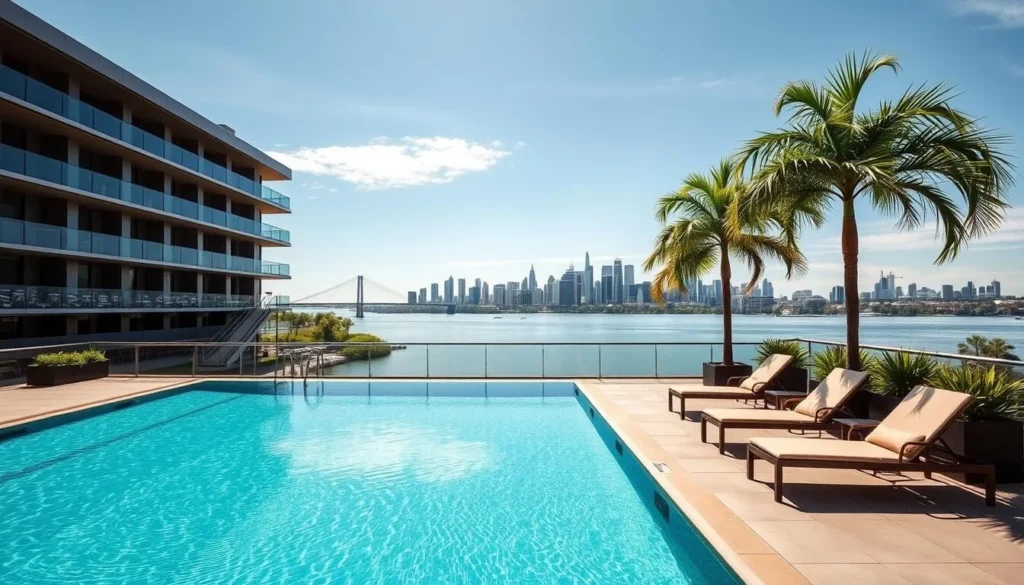
Your accommodation choice in Brisbane should consider the seasonal weather patterns. During summer months (December-February), prioritize properties with good air conditioning and possibly a pool. In winter (June-August), river views are particularly spectacular under clear skies.
Recommended Areas to Stay
Brisbane CBD
Central location with easy access to all attractions. Hotels here typically offer excellent air conditioning for summer months and are close to the river for pleasant winter strolls.
Best for: First-time visitors, business travelers
Weather consideration: Good option year-round with indoor connections to shopping and dining
South Bank
Cultural precinct with parklands and artificial beach. Excellent for families, especially during the dry winter months when outdoor activities are most enjoyable.
Best for: Families, culture enthusiasts
Weather consideration: Particularly pleasant during May-October for outdoor enjoyment
New Farm & Fortitude Valley
Trendy areas with restaurants, cafes, and nightlife. These neighborhoods offer a mix of indoor and outdoor venues, making them suitable year-round.
Best for: Young travelers, foodies, nightlife seekers
Weather consideration: Good balance of indoor/outdoor options for variable weather
Find Your Perfect Brisbane Stay
Browse accommodations with weather-appropriate amenities for your visit.
Dining & Local Cuisine

Brisbane’s dining scene adapts beautifully to the changing seasons. During the cooler, drier months (May-September), the city comes alive with outdoor dining options along the river and in neighborhood precincts.
Weather-Based Dining Recommendations
Dry Season Dining (May-October)
- Howard Smith Wharves: Riverside precinct with stunning views and outdoor seating
- Eagle Street Pier: Waterfront dining with panoramic river views
- South Bank restaurants: Alfresco options with parkland views
- Eat Street Northshore: Open-air food market with international cuisines
Wet Season Options (November-April)
- Queen Street Mall: Covered shopping precinct with numerous dining options
- Brisbane Quarter: Upscale indoor dining with views
- Fortitude Valley: Mix of indoor restaurants and bars
- West End: Cozy cafes and restaurants with indoor seating
Don’t miss trying local Queensland specialties like Moreton Bay bugs (a type of lobster), fresh tropical fruits, and excellent seafood. The subtropical climate means Brisbane has access to outstanding fresh produce year-round.
Attractions, Sightseeing & Activities

Brisbane’s attractions can be enjoyed year-round, but certain activities are better suited to specific weather conditions. Here’s how to make the most of your sightseeing based on when you visit.
Weather-Optimized Itineraries
Dry Season Activities (May-October)
- Mount Coot-tha Lookout: Panoramic city views best enjoyed on clear winter days
- Lone Pine Koala Sanctuary: Outdoor wildlife experience comfortable in cooler weather
- Brisbane River cruises: Spectacular during winter’s clear skies
- City Botanic Gardens: Pleasant strolls in mild temperatures
- Story Bridge Adventure Climb: More comfortable in cooler months
Wet Season Alternatives (November-April)
- Queensland Museum & Science Centre: Indoor cultural experience
- Gallery of Modern Art (GOMA): World-class art in air-conditioned comfort
- Queensland Maritime Museum: Indoor and covered exhibits
- The Workshops Rail Museum: Indoor historical attraction
- Shopping at Queen Street Mall: Covered retail therapy
Discover Brisbane’s Best Experiences
Book guided tours and activities with flexible cancellation options in case of weather changes.
Museums, Cultural Spots & Festivals

Brisbane’s cultural calendar is thoughtfully aligned with the city’s weather patterns, with major outdoor festivals scheduled during the dry season and plenty of indoor cultural venues available year-round.
Weather-Aligned Festival Calendar
| Month | Major Festivals & Events | Weather Considerations |
| May | Paniyiri Greek Festival Brisbane Comedy Festival Brisbane Street Art Festival | Excellent outdoor festival weather with mild temperatures and low humidity |
| June | State of Origin rugby matches Brisbane Marathon | Cool, dry conditions perfect for sporting events |
| July | Anywhere Festival Regional Flavours food festival | Clear, sunny days with cool evenings |
| August | Royal Queensland Show (Ekka) Bridge to Brisbane fun run | Dry, sunny days perfect for outdoor events |
| September | Brisbane Festival Riverfire fireworks Brisbane Pride Festival | Ideal outdoor event weather before summer humidity |
| October | Valley Fiesta Brisbane International Film Festival | Warm but not hot, with jacarandas in bloom |
Year-Round Cultural Venues
Brisbane’s Cultural Precinct at South Bank houses world-class museums and galleries that provide air-conditioned comfort during summer and cozy cultural experiences in winter:
- Queensland Art Gallery & Gallery of Modern Art (QAGOMA): World-class art collections
- Queensland Museum & Science Centre: Natural history and interactive exhibits
- Queensland Performing Arts Centre (QPAC): Theater, ballet, and musical performances
- State Library of Queensland: Exhibitions and literary events
Sports, Nature & Outdoor Experiences
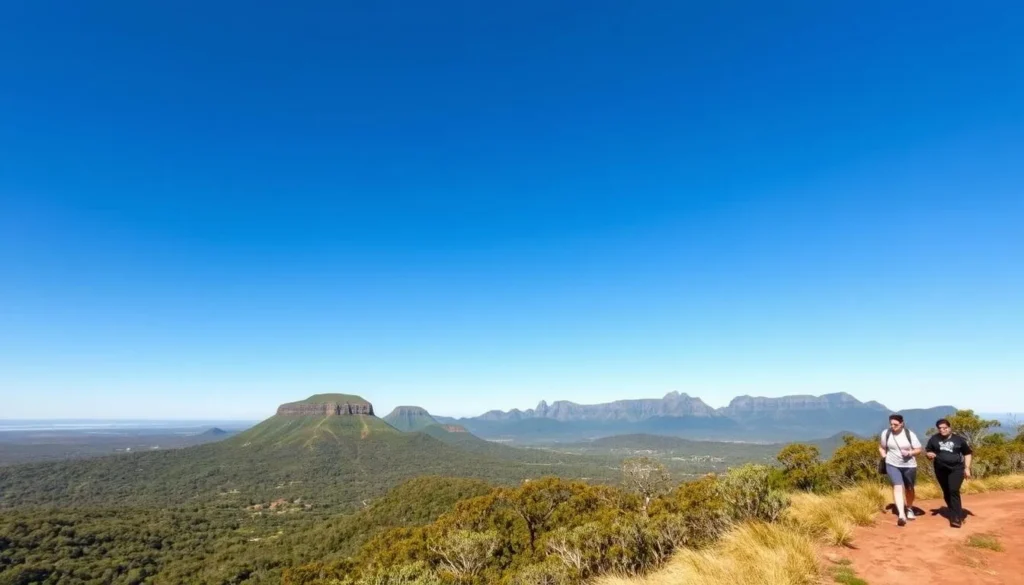
Brisbane’s subtropical climate allows for outdoor activities year-round, but timing your adventure sports and nature experiences with the right season can make a significant difference to your enjoyment.
Seasonal Outdoor Recommendations
Water Activities
Best time: October-April for warmest water
Activities: Kayaking the Brisbane River, Moreton Bay sailing, Stand-up paddleboarding
Weather tip: Early mornings are best during summer to avoid afternoon thunderstorms
Hiking & Nature
Best time: May-September for comfortable temperatures
Destinations: Mount Coot-tha trails, Tamborine Mountain, Springbrook National Park
Weather tip: Winter offers clearest views from lookouts and most comfortable hiking conditions
Wildlife Experiences
Best time: June-October for whale watching, year-round for koalas and kangaroos
Destinations: Lone Pine Koala Sanctuary, Moreton Bay (whales), North Stradbroke Island
Weather tip: Animals are often more active during cooler morning hours
Experience Brisbane by Sea
Brisbane is a popular cruise port. Explore cruise options that visit during the ideal weather months.
Safety, Etiquette & Local Customs

Brisbane is generally a safe and friendly destination, but there are some weather-related safety considerations and local customs to be aware of during your visit.
Weather Safety Tips
- Sun protection: Brisbane’s UV index is extremely high year-round. Wear sunscreen (SPF 50+), a hat, sunglasses, and protective clothing even on cloudy days.
- Hydration: The subtropical climate requires consistent hydration, especially during summer months.
- Storm awareness: During summer (December-February), be aware of afternoon thunderstorms which can develop quickly. Seek shelter when storms approach.
- Heat safety: During summer, plan outdoor activities for early morning or late afternoon to avoid the midday heat.
- Swimming safety: Only swim at patrolled beaches and between the flags. Be aware of marine stingers during summer months.
Local Customs & Etiquette
Australians are generally relaxed and informal, but there are some cultural norms to observe:
- Tipping: Not expected in Australia as service staff receive good wages. Optional for exceptional service.
- Greetings: Casual and friendly. First names are commonly used even in business settings.
- Punctuality: Australians are generally punctual for business and social engagements.
- Dress code: Generally casual, but smart casual for nicer restaurants. Weather-appropriate clothing is always acceptable.
- Indigenous respect: Show respect when visiting sites of Aboriginal significance and during cultural performances.
Practical Travel Tips
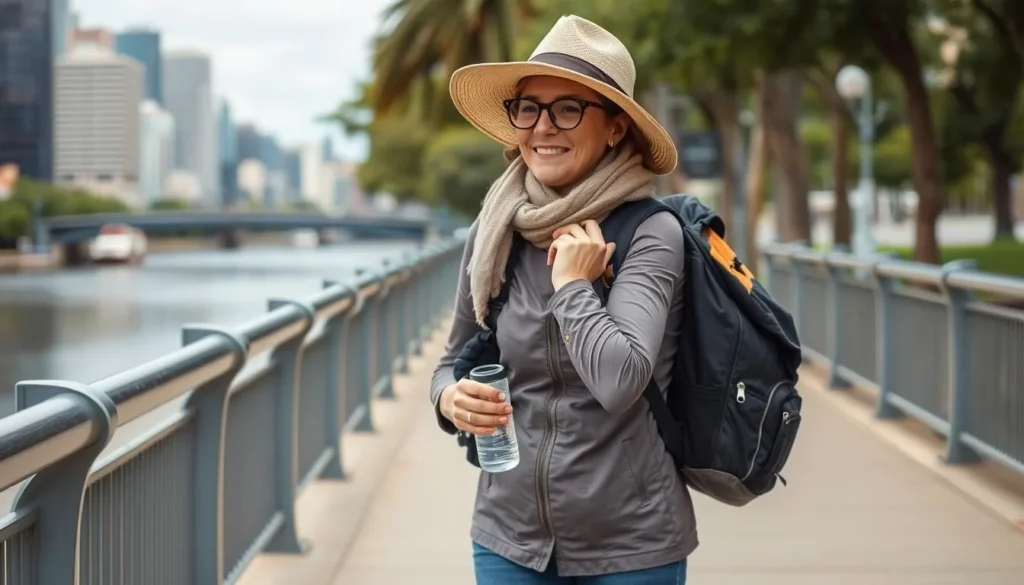
Weather-Based Packing List
Summer (December-February)
- Lightweight, breathable clothing
- Multiple swimsuits
- High-SPF sunscreen
- Wide-brimmed hat
- Sunglasses with UV protection
- Lightweight rain jacket
- Insect repellent
- Reusable water bottle
Winter (June-August)
- Light layers for daytime
- Light jacket or sweater for evenings
- Long pants/jeans
- Comfortable walking shoes
- Sunscreen (still necessary!)
- Sunglasses
- Light scarf
- Swimwear (for heated pools)
Additional Tips
- Transportation timing: Brisbane’s CityCat ferries are most enjoyable during winter months when the weather is clear and pleasant.
- Early starts: During summer, plan outdoor activities for early morning to avoid midday heat and afternoon storms.
- Booking flexibility: Consider flexible booking options during the wet season (December-February) in case of weather disruptions.
- Go Card: Purchase a TransLink Go Card for public transportation, which works on buses, trains, and ferries.
- Water activities: The Brisbane River is warmest from December to April, but clearest during the dry winter months.
Ready for Your Brisbane Adventure?
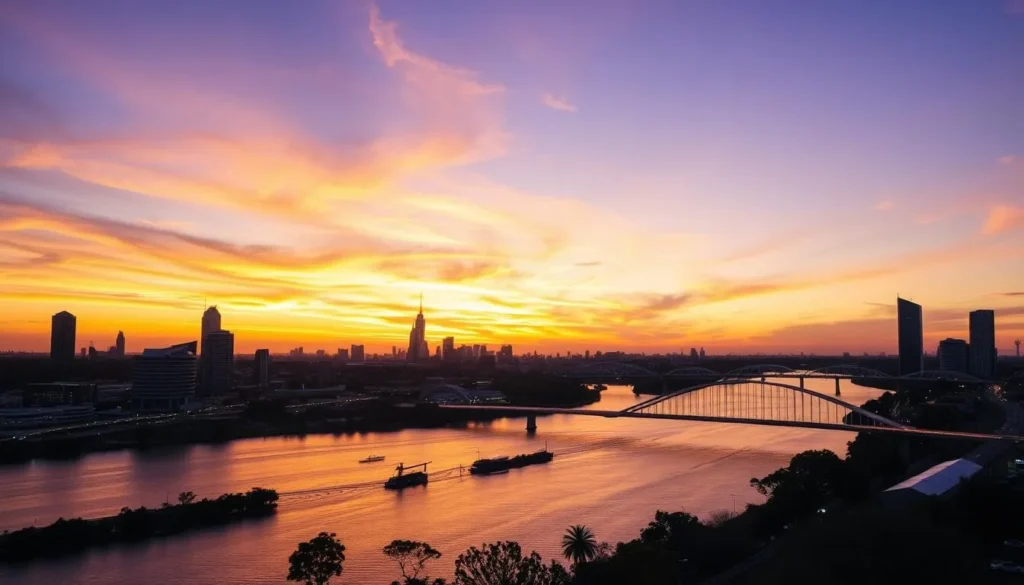
Brisbane’s subtropical climate offers something for every traveler throughout the year, but timing your visit between May and October will reward you with the most comfortable weather conditions. With 283 sunny days annually, Brisbane truly deserves its reputation as a sunshine destination. Whether you’re exploring the vibrant cultural precinct, cruising the Brisbane River, or venturing to nearby natural wonders, understanding the city’s seasonal patterns will help you pack appropriately and plan the perfect itinerary. So grab your sunscreen, book your flights, and prepare for an unforgettable Queensland adventure in beautiful Brisbane!
The above is subject to change.
Check back often to TRAVEL.COM for the latest travel tips and deals.
